Determination of Preservatives in Cosmetics and Personal Care Products by LC–MS-MS
Special Issues
A liquid chromatography–electrospray ionization tandem mass spectrometry (LC–ESI-MS-MS) method has been developed to determine multiple preservatives in cosmetics and personal care products.
A liquid chromatography–electrospray ionization tandem mass spectrometry (LC–ESI-MS-MS) method has been developed to determine multiple preservatives in cosmetics and personal care products.
Cosmetic and personal care products that contain water require protection against the growth of microorganisms to ensure product safety. Preservatives are natural or synthetic ingredients added to products to prevent spoilage, microbial growth, undesirable chemical changes, or to extend the product's shelf life (1). The use of preservatives in personal care products is important because not only do they prevent product damage caused by microorganisms but they also help protect the product from inadvertent contamination by the consumer during use. Without the addition of preservatives, the product may become contaminated, which can lead to product degradation and, in the case of cosmetic foundations, ultimately increase the risk of irritation or even infection. Preservatives are added to personal care products at relatively low levels to ensure products remain safe and perform as intended over their lifetime. The determination of preservatives in these products is important for quality control to prevent allergic reactions and other health issues.
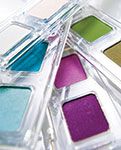
The most widely used preservatives in cosmetic products are a class of compounds generally referred to as parabens (1). These compounds are alkyl esters of p-hydroxybenzoic acid (Figure 1). They are used for their preservative properties in cosmetic and personal care products because of their antimicrobial activities, low toxicity, and low production cost (2). Methylparaben (MeP) is found in nearly all cosmetics and many pharmaceuticals (3). The use of parabens in personal care products has caused concern because of their potential adverse effects, including proliferation of breast cancer (4–8) and reduction of sperm count and testosterone levels (9–12). The United States Food and Drug Administration (FDA) finds that although parabens can mimic estrogen, the levels found in these products are at such low levels that their activity on the body does not cause cancer in any higher incidence than naturally occurring estrogen despite contrary belief (13). However, when counterfeit products make it to market, they are unregulated and may contain preservative levels that may pose a health risk to the user. Therefore, accurate methods to determine the levels of these compounds need to be available for monitoring preservative concentrations in cosmetic and personal care products.
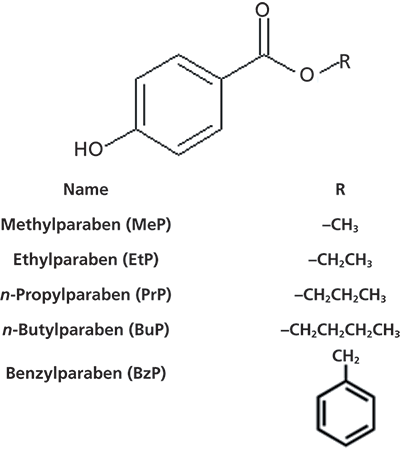
Figure 1: Chemical structures of parabens.
Current analytical methods for the determination of preservatives in cosmetic and personal care products include high performance liquid chromatography (HPLC) (14,15), ultrahigh-pressure liquid chromatography (UHPLC) (16), UHPLC–tandem mass spectrometry (MS-MS) (17), gas chromatography–mass spectrometry (GC–MS) (18), GC (19,20), solid-phase microextraction (SPME)-GC–MS-MS (21), and micellar electrokinetic chromatography (MEKC) (22).
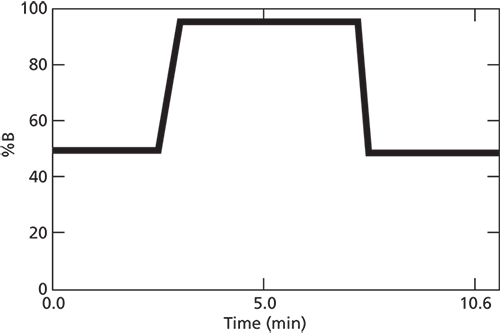
Figure 2: Gradient profile of %B versus time.
Most methods have previously determined single preservatives in pharmaceutical or personal products. The methods that have been published have focused on a small group of preservatives, but only a few methods have included the simultaneous measurement of multiple preservatives. Methods for the preservative analysis of cosmetic products have mainly focused on the determination of parabens. The analysis of more than one class of preservatives is still a field under development. We have included not only parabens in this study, but also compounds such as DL-α-tocopherol acetate (Toco) and butylated hydroxytoluene (BHT). In previous chromatographic methods the sample preparation has focused on specific product categories; most are GC methods requiring derivatization. Currently, there is no universally accepted sample preparation or analytical method for different types of sample matrices such as pastes, liquids, creams, and ointments. In this study, we have developed a simple sample preparation method using liquid chromatography–electrospray ionization tandem mass spectrometry (LC–ESI-MS-MS) to analyze preservatives in cosmetic and personal care products using a relatively small sample, 100 mg. Experimental conditions were optimized for sample preparation and analysis to achieve maximum sensitivity and accuracy. The optimized method was used to analyze the following preservatives: methylparaben, ethylparaben, propylparaben, isopropylparaben, benzylparaben, butylparaben, triclosan, DL-α-tocopherol acetate, butylated hydroxyanisole (BHA), and butylated hydroxytoluene (BHT). The procedure can simultaneously analyze these preservatives in a single chromatographic analysis of various kinds of sample matrices from cosmetic and personal care products.
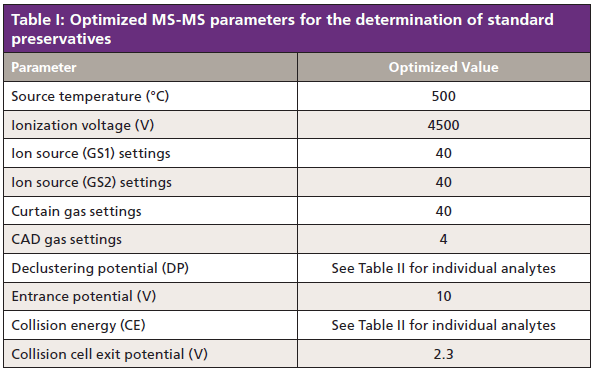
Experimental
Sample Preparation
Cosmetic and personal care samples were purchased from local stores. Products analyzed included lipstick, foundations, deodorant, hand lotion, hand soap, and toothpaste. Standard preservative sample and cosmetic and personal care product preparation was as follows: 100 mg sample was placed into 5 mL of 1:1 (v/v) methanol–acetonitrile. This solution was then sonicated for approximately 10 min and then centrifuged for 5 min at 800g. The supernatant was then filtered using a 0.2-μm Millipore filter. Then, 1 mL of the filtered supernatant was placed into an autosampler vial along with 60 μL of 100 ppm internal standard (BHA).
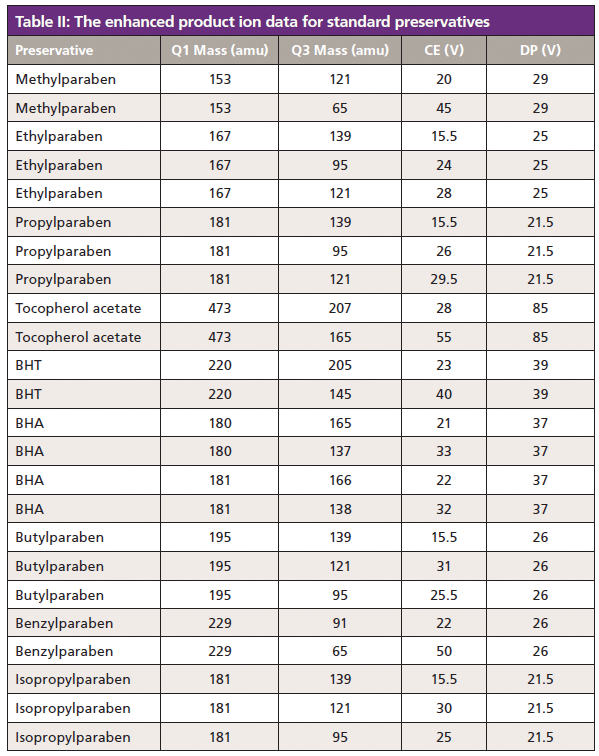
The following reagents were purchased from VWR: HPLC-grade methanol, HPLC-grade water, formic acid, and acetonitrile.
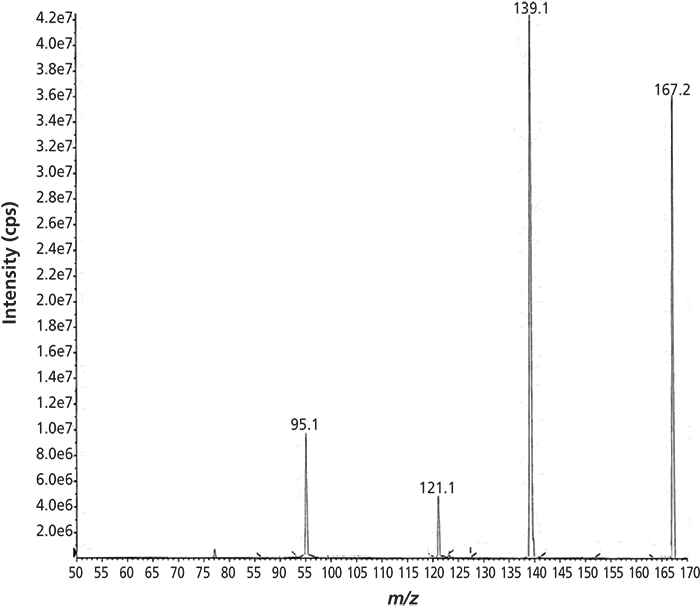
Figure 3: Enhanced product ion 10 eV ethylparaben spectrum (Q1 mass: 167 amu; Q3 masses: 95, 139 amu).
Preservative Standards
The following preservatives were purchased from Sigma Aldrich: ethyl 4-hydoxybenzoate (ethylparaben) (lot STBC0530V), propyl 4-hydroxybenzoate (propylparaben) (lot BCBK9343V), methyl 4-hydroxybenzoate (methylparaben) (lot MKBG5184V), butyl 4-hydroxybenzoate (butylparaben) (lot MKBR1951V), benzyl 4-hydroxybenzoate (benzylparaben) (lot MKBL1242V), triclosan (lot LRAA1072), and butylated hydroxyanisol (BHA) (lot MKBJ4456V). The preservatives DL-α-tocopherol acetate (lot SLBB9917V) and 2,6-di-tert-butyl-4-methylphenol (BHT) (lot 10156687) were purchased from Alfa Aesar. Isopropylparaben (lot S5QHD-CE) was purchased from Santa Cruz Biotechnology.
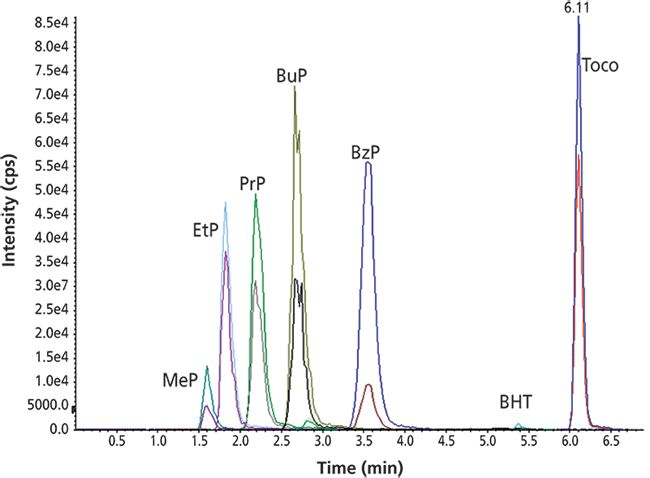
Figure 4: Chromatogram of standard preservative mixture (methylparaben = MeP; ethylparaben = EtP; propylparaben = PrP; butylparaben = BuP; benzylparaben = BzP; butylated hydroxytoluene = BHT; tocopherol acetate = Toco).
Liquid Chromatography
Liquid chromatography was performed on a Shimadzu LC-20 Prominence system equipped with two Shimadzu LC-20 AD prominence liquid chromatography binary pumps, a Shimadzu DGO-20A3 Prominence degasser, and a Shimadzu SIL-20AC Prominence autosampler. A 50 mm × 3.0 mm, 3.0-μm Ultra Biphenyl column (Restek) was used for all analyses. A binary mobile phase was used: the weak mobile phase (A) was 0.1% (v/v) formic acid in HPLC-grade water and the strong mobile phase (B) was 0.1% (v/v) formic acid in 2-propanol. The flow rate was 0.3 mL/min. Before running the method on the preservative standards and samples, the lines and the column were flushed using the mobile phase to elute any compounds that may have been present. Pumps A and B were also purged before any experimental run to eliminate any cross contamination. The LC oven temperature was held constant at 25 °C. To obtain optimal separation the following gradient was used: start with 50% B and hold for 2.5 min; from 2.50 to 3.00 min linearly increase the concentration of B to 95%; hold the concentration of B at 95% to 7.5 min. After completion of the data acquisition, the concentration of B was dropped back to 50% and the column was allowed to reequilibrate for 3 min. The gradient profile can be seen in Figure 2. The autosampler injection volume was set constant at 2 μL for each sample.
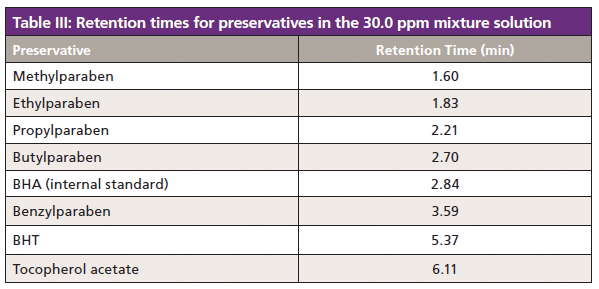
Mass Spectrometry
MS analysis of all samples was performed on an AB Sciex 3200 QTRAP triple-quadrupole mass spectrometer equipped with an ESI interface. Electrospray ionization was carried out in positive-ion mode. Q1 and Q3 were both operated with unit resolution. The source temperature was 500 °C and the ionization voltage was 4500 V. The preservatives were quantified in multiple reaction monitoring (MRM) mode with a dwell time of 100 ms. Optimized parameters for MS-MS analysis are listed in Table I. The collision energy (CE) and declustering potential (DP) for each preservative analyte are listed in Table II.
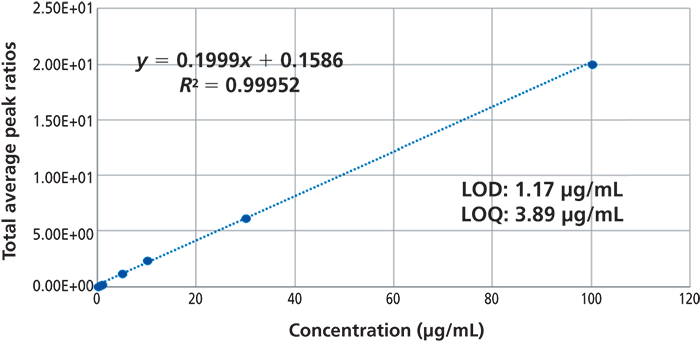
Figure 5: Calibration curve for ethylparaben.
Results and Discussion
Using 100 ppm preservative stock solutions, the enhanced product ions (EPIs) for each preservative were determined using ESI-MS-MS with the exception of BHT, whose EPI spectrum was determined using a 1000 ppm solution. The data obtained are listed in Table II, and an example EPI spectrum of ethylparaben can be seen in Figure 3. The LC gradient conditions were optimized to achieve the best separation of a mixture of standard preservatives. The chromatogram of a standard preservative mixture (30.0 ppm each) can be seen in Figure 4. The respective retention times of the standard preservatives in the mixture are listed in Table III. The relative responses of the parabens were consistent. However, BHT showed poor ionization efficiency and did not give enough of a response to give detection limits that were acceptable enough to detect it in some samples. On the other hand, DL-α-tocopherol acetate gave a larger response than the parabens. We attempted to include triclosan in the method, but it was only detectable in the negative ion mode so this analyte was not included in the procedure.
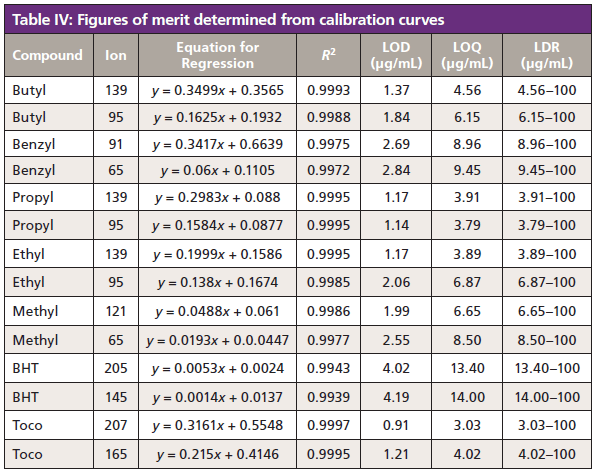
The following calibrator solutions were made by dilution with HPLC-grade methanol of the stock preservative mixture solution: 0.1, 0.5, 1.0, 5.0, 30.0, 70.0, and 100.0 ppm. Calibration curves were generated by analyzing samples in triplicate over six days. As an example, the calibration curve for ethylparaben can be seen Figure 5. Figures of merit were obtained from the calibration curve data. The figures of merit data for all of the preservatives including the equation for regression, R2 values, limit of detection (LOD), and limit of quantification (LOQ) are listed in Table IV. All analytes produced linear data plots with R2 values >0.99. The LOD and LOQ were determined by first plotting the calibration curves for each standard preservative. After they were plotted, the following equation was used to calculate the LOD:

and LOQ was calculated using the following equation:

The LOD and LOQ values from each individual preservative resulted in an overall LOD range of 0.91–4.19 ppm and an LOQ range of 3.03–14.00 ppm.

Figure 6: Chromatogram of toothpaste sample. Preservative peaks (left to right): methylparaben, ethylparaben, and BHA (internal standard).
Using the sample preparation procedure described above, the chromatographic method was applied to the following cosmetics and personal care products: foundations, lipstick, deodorant, hand lotion, hand sanitizer, and toothpaste. Sample preparation was identical to that used to create the standard preservative solutions. For example, the chromatogram of a toothpaste sample can be seen in Figure 6. Methylparaben and ethylparaben were both detected in this sample. Figure 7 shows the chromatogram from a foundation sample. The preservative peaks methylparaben, ethylparaben, and propylparaben as well as the peak for the internal standard, BHA, can easily be seen. Although the peaks for BHT and DL-α-tocopherol acetate cannot be readily observed on the chromatogram since they were present in relatively low concentrations, they were detected and quantified. The percent concentrations for the samples analyzed are listed in Table V. BHT, methylparaben, and ethylparaben were detected in most of the samples. Benzylparaben and butylparaben were not detected in any of the samples tested. Figure 8 is a bar graph comparing the relative quantities of the different preservatives in the sample products tested. It is interesting to note that the deodorant sample tested and one of the foundation samples (F4) had relatively larger quantities of parabens compared to the other products. Specifically, methylparaben and ethylparaben were present in larger concentrations. Propylparaben was also detected in the one foundation sample (F4).
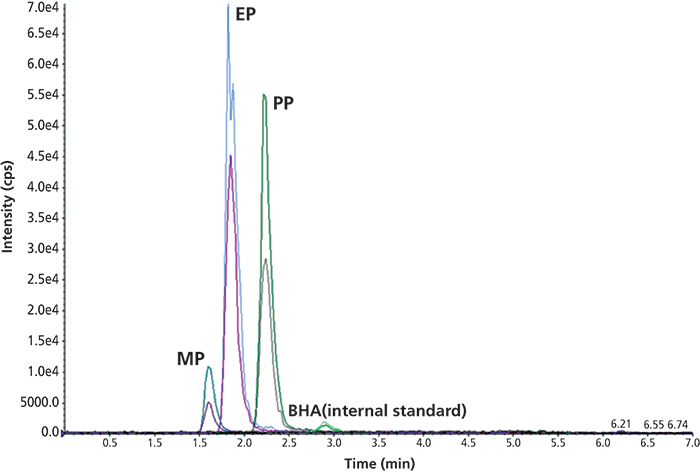
Figure 7: Chromatogram of foundation sample (F4). Preservative peaks (left to right): methylparaben, ethylparaben, propylparaben, and BHA (internal standard).
It was noticed that some of the products analyzed contained peaks belonging to preservatives that were not listed on the product label ingredient list. For example, in the foundation sample (Figure 7) the chromatogram shows peaks consistent with methylparaben, ethylparaben, and propylparaben; however, these preservatives were not listed on the ingredient list of the product label. The analysis of the hand lotion sample also resulted in an ethylparaben peak, but ethylparaben is not listed on the product label ingredient list. Similarly, the toothpaste sample contained methylparaben and ethylparaben peaks yet they were not listed on the product ingredient list. Unfortunately, the threshold values are unclear for preservatives in cosmetics and personal care products sold in the United States. Because of this, the FDA may not require companies to list certain preservatives if they fall below a certain cutoff value. However, the European Union has a set maximum concentration of preservatives allowed in cosmetics, as follows: 0.4% one single ester, 0.8% ester mixtures of parabens, 0.5% benzoic-salicylic acid, 0.6% sorbic acid, and 1.0% phenoxyethanol (15).
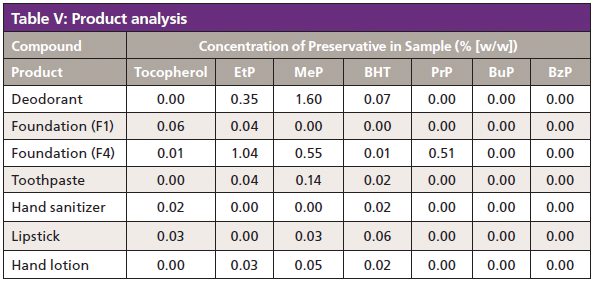
Conclusion
An LC–ESI-MS-MS method has been developed to determine multiple preservatives in cosmetic and personal care products. The sample preparation is short and simple and when combined with the optimal chromatographic conditions, the method allows for a quick analysis time. In under 8 min, the developed method is capable of separating and identifying eight preservatives (including five parabens) in a 100-mg sample of cosmetic and personal care product with an LOD ranging from 0.91 to 4.19 μg/mL and an LOQ ranging from 3.03 to 14.00 μg/mL. Compared to other literary references, this method combines a simple and cheap sample preparation procedure along with a short analysis time while providing similar if not improved separation and sensitivity.

Figure 8: Relative quantities of preservatives in cosmetic and personal care products analyzed.
Acknowledgments
This research was supported by the Forensic Science Program in the Chemical and Physical Sciences Department of Cedar Crest College and the 2014 Carol DeForest Research Grant, Northeastern Association of Forensic Scientists.
Emily A. Myers, Thomas H. Pritchett, and Thomas A. Brettell are with the Forensic Science Program in the Department of Chemistry and Physical Sciences at Cedar Crest College in Allentown, Pennsylvania. Direct correspondence to: eamyers@cedarcrest.edu
References
(1) http://www.cosmeticsinfo.org/HBI/6 (last accessed January 8, 2014).
(2) M. Soni, I. Carabin, and G. Burdock, Food Chem. Toxicol. 43, 985 (2005).
(3) I Branowska, I. Wojciechowska, N. Solarz, and E. Krutysza, J. Chromatogr. Sci. 52, 88–94 (2014).
(4) Q. Zhang, M. Lian, L. Liu, and H. Cui, Anal. Chim. Acta 537, 31–39 (2005).
(5) J. Byford, L. Shaw, M. Drew, G. Pope, M. Sauer, and P. Darbre, J. Steroid Biochem. Mol. Biol. 80, 49 (2002).
(6) P. Darbre, J. Byford, L. Shaw, R. Horton, G. Pope, and M. Sauer, J. Appl. Toxicol. 22, 219 (2002).
(7) P. Darbre, J. Byford, L.Shaw, S. Hall, N. Coldham, and M. Sauer, J. Appl. Toxicol . 23, 43 (2003).
(8 )P. Darebre, A. Aljarrah, W. Miller, N. Coldham, M. Sauer, and G. Pope, J. Appl. Toxicol. 24, 5 (2004).
(9) S. Oishi, Toxicol. Ind. Health 17, 31 (2001).
(10) S. Oishi, Arch. Toxicol. 76, 423 (2002).
(11) D. Oishi, Food Chem. Toxicol. 40, 1807 (2002).
(12) X.Q. Li et al., Anal. Chim. Acta 608, 165–177 (2008).
(13) http://www.truthinaging.com/ingredients/ethylparaben-2 (last accessed January 6, 2014).
(14) P. Perez-Lozano, E. Garcia-Montoya, A. Orriols, M. Minarro, J.R. Tico, and J.M. Sune Negre, J. of Pharmaceutical and Biomed. Anal. 39, 920–927 (2005).
(15) A. Aoyama, T. Doi, T. Tagami, and K.J. Kajimura, Chromatogr. Sci. 51, 1–6 (2013).
(16) T. Wu, C. Wang, X. Wang, and Q. Ma, J. Cosmetic Sci. 30, 367–372 (2008).
(17) M. Pedrouzo, F. Borrull R.M. Marce, and E. Pocurull, J. Chromatogr. A 1216, 6994–7000, (2009).
(18) A.M.C. Ferreira, M. Moder, and M.E.F. Laepada, J. Chromatogr. A 1218, 3837–3844 (2011).
(19) M. Abbasghorbani, A. Attaran, and M. Payehghadr, J. Sep. Sci. 36, 311–319 (2013).
(20) H. Wei, J. Yang, H. Zhang, and Y. Shi, J. Sep Sci. 37, 2349–2356 (2014).
(21) G. Alvarez-Rivera, M. Vila, M. Lores, C. Garcia-Jares, and M. Llompart, J. Chromatogr. A 1339, 13–25 (2014).
(22) F. Han, Y.Z He, and C.Z. Yu, Talanta 74, 1371–1377 (2008).
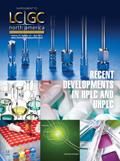
Reversed-Phases for LC Deliberately Doped with Positive Charge: Tips and Tricks for Effective Use
May 13th 2025In this month's edition of LC Troubleshooting, Dwight Stoll and his fellow researchers discuss both the benefits (improved peak shape/loading) and challenges (excessive interaction) associated with charge-doped reversed-phase (RP) columns for both analytical and preparative separations.
Investigating 3D-Printable Stationary Phases in Liquid Chromatography
May 7th 20253D printing technology has potential in chromatography, but a major challenge is developing materials with both high porosity and robust mechanical properties. Recently, scientists compared the separation performances of eight different 3D printable stationary phases.
Characterizing Polyamides Using Reversed-Phase Liquid Chromatography
May 5th 2025Polyamides can be difficult to characterize, despite their use in various aspects of everyday life. Vrije Universiteit Amsterdam researchers hoped to address this using a reversed-phase liquid chromatography (RPLC)-based approach.
New Method Explored for the Detection of CECs in Crops Irrigated with Contaminated Water
April 30th 2025This new study presents a validated QuEChERS–LC-MS/MS method for detecting eight persistent, mobile, and toxic substances in escarole, tomatoes, and tomato leaves irrigated with contaminated water.

.png&w=3840&q=75)

.png&w=3840&q=75)



.png&w=3840&q=75)



.png&w=3840&q=75)










